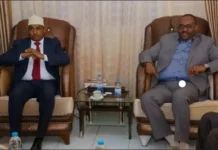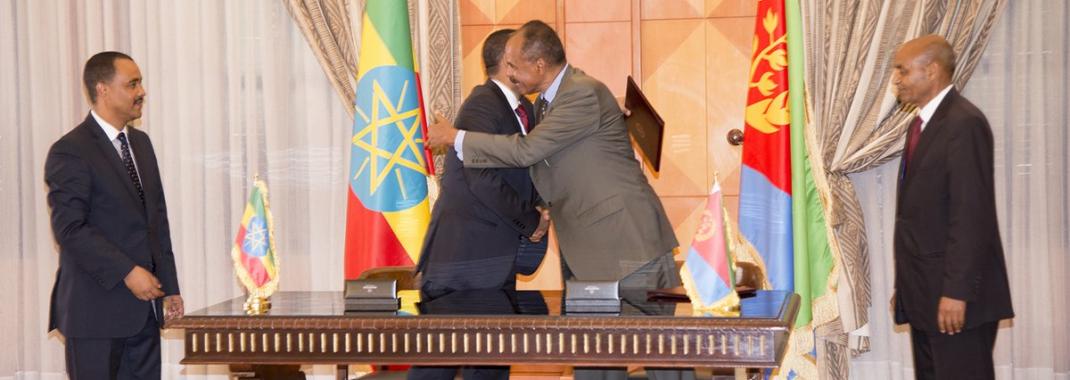BANNER IMAGE: Prime Minister Abiy Ahmed and President Isaias Afewerki embrace after signing the Joint Declaration of Peace and Friendship ending the border dispute between their two countries and re-establishing diplomatic relations. Courtesy of Yemane Gebremeskel, Minister of Information of the State of Eritrea/Wikipedia
The ‘Eritrean problem’ is often lumped along with the Israeli–Palestinian conflict as an intractable ‘historical conundrum’, with cultural divergences, historical grievances and ideological difference all combining into an ‘unmanageable whole’. So, the apparent progress registered over the past few months is surprising.
Instigated, at least nominally, over disputed border territories lacking strategic or economic value, the 1998 war between Asmara and Addis Ababa lasted two years and cost roughly 80,000 lives. The UN-supervised Algiers peace deal signed in 2000 merely re-framed the parameters of conflict: Eritrea outsourced militancy to regional proxies and Ethiopia launched airstrikes on training camps (2012), weapon depots, and industrial assets (2015). A cycle of protracted violence has since persisted until this year.
By launching a metaphoric ‘bridge of love’ between Ethiopia and Eritrea, and signing a Joint Declaration of Peace and Friendship in July 2018, Ethiopian Prime Minister Ahmed Abiy upended this deadlock completely.. The two countries are already restoring telecommunication links, resuming direct flights, reopening embassies, and discussing export leases. Abiy also submitted a request to dismantle the UN sanctions regime imposed on Asmara in 2009 and, crucially, accepted the legal demarcations outlined in the 2000 Algiers Deal, which necessitate a withdrawal of Ethiopian National Defense Forces from the contested town of Badme without the usual economic preconditions demanded by past Ethiopian governments. Aspirations of ‘peace’ have been staples in Ethiopian political discourse for years,but the progress made since June is unprecedented.
Now, the key question is whether this progress can be sustained.
The recent leadership transition in Addis Ababa has fostered a climate conducive to ‘fresh thinking’ with Abiy’s election in April 2018 carving space for bold domestic reform and disrupting the norms of Ethiopian governance. As an ethnic-Oromo, Abiy operates outside the usual patron-client networks controlled by a Tigrayan elite, which has conserved power for two decades through the Tigrayan People’s Liberation Front (TPLF) – a constituent party of the ruling Ethiopian People’s Revolutionary Democratic Front (EPRDF) coalition. Motivated in large part by political survival, Abiy has already begun dismantling these vested interests, instigating changes that have a direct impact on the ‘Eritrean question’.
Eritrean President Isaias Afwerki often references identifies the TPLF’s ‘toxic and malignant legacy’ as the fundamental impediment to peace, and the enmity between Eritrea and Ethiopia can at least be partially understood as a subnational rivalry between Asmara and the adjacent province of Tigray. As the nucleus of ‘Africa Orientale Italiana’, Eritrea’s colonial experience under both Italian and British domination accelerated the proliferation of local industrial infrastructure beyond those of its neighbours, granting significant commercial advantages. These disparities raised Ethiopian fears, particularly in agrarian-based and developmentally out-competed Tigray, it could become over-dependent on manufacturing and financial services in Asmara. Accentuating these fears by labeling any subsidy for Tigrayan infant industries as ‘wasteful duplication’, Isaias repeatedly sought to exploit Ethiopian, and Tigrayan, economic vulnerabilities. There has therefore been little appetite in Addis Ababa to negotiate with Eritrea, especially given the political, social and corporate interests of the TPLF ensconced in Tigray. Abiy’s reforms are starting to remove this baggage and may help mitigate the impact of Tigrayan spoilers, producing opportunities for more genial inter-state dialogue.
Reconciliation will also likely be made more durable by longer-term structural shifts in East African regional relations. Analogous agreements, at least partially nurtured by Ethiopian oversight, have been signed between Asmara and both Djibouti and Somalia. More broadly, donors like Saudi Arabia and the UAE are investing in port construction and naval infrastructure in Eritrea, as part of their war effort in Yemen; Germany is resuming a tranche of technical assistance programmes; and Egypt has strengthened bilateral relationsas it tries to counter the perceived threat of Ethiopia’s Grand Renaissance Dam. The EU has similarly approved a 200 million euro aid package replete with capacity building schemes in 2015. While these funds are contingent on various ethical conditions, a large proportion has already been allocated to the Eritrean energy sector, creating opportunities for Isaias to leverage additional revenue streams. The tentative re-emergence of Asmara from its pariah status of the 1990s is therefore testament to a new strategic reality, and one which Ethiopia will have to accept, regardless of the twists in Ethiopia’s domestic policies.
Still, the greatest uncertainty to a sustainable peace comes from Eritrea itself. Following a catastrophic military defeat in 1998, Isaias reconfigured the country as a garrison state; adopting a political–business strategy designed to both resist the threat of Ethiopian invasion and ensure his own survival, both politically and literally. Indefinite military conscription has sustained an army of over 200,000 soldiers, creating a huge financial burden which is increasingly unsustainable. Poverty remains chronic and domestic food production is well below the necessary requirements. Isaias’ regime has exhausted any popular legitimacy it once had, relying on coercion, patronage and memories of the ‘liberation struggle’ to sustain power. Fear of Ethiopia is integral to this mixture, and the government therefore seems unlikely to discard a narrative that justifies its authoritarianism, especially as any form of demobilisation could prove fatal. As Martin Plaut, a senior British academic and expert on the region argues: ‘if tens of thousands of young national servicemen and women are allowed to go home, what jobs await them?’
Nevertheless, history shows even Isaias’s autocratic system can adapt under the right conditions. Its underlying dynamics largely derive from the retail logic of a ‘political marketplace’, where governance is defined by monetised transactions. As a result, these political bargains are often highly receptive to new incentive structures and contextual fluctuations, and change is already evident in Asmara. Under the pressures of international sanctions and domestic corruption, the original monopolisation of economic and political capital under Isaias has given way to an incremental process of marketisation. The Eritrean elite can now levy conscripts for independent parastatal and agricultural projects, and army commanders have captured strategic rents through a litany of shell companies, incrementally decentralising and diffusing the political marketplace.
In this context, the expansion of Eritrean extractive industries may help transform the system further in ways favorable to peace. With the opening of the Bisha gold mine in 2011, a shared venture between Asmara and Nevsun, mineral exports has rapidly become the country’s biggest revenue source. Reserves of zinc, copper and potash remain untapped, and the government has a clear interest in enticing foreign direct investment to help resurrect its economic potential. It is unlikely that conscription will be entirely suspended, but a new, lucrative dispensation based on mineral rents may help buy internal support for reconciliation from Eritrea’s kleptocratic stakeholders. Questions linger over the durability of a political concord without concurrent provisions for inclusive, accountable governance, but it nevertheless creates opportunities for further reconciliation in the long term.
So, while peace remains hostage to the idiosyncratic whims of an ageing Eritrean dictator, it has been bolstered by a confluence of structural and regional transformations that ensures peace is in the interest of both parties. So far they have concentrated on the low hanging fruit, but there is unprecedented scope, incentive and momentum to sustainably resolve this confrontation.







































